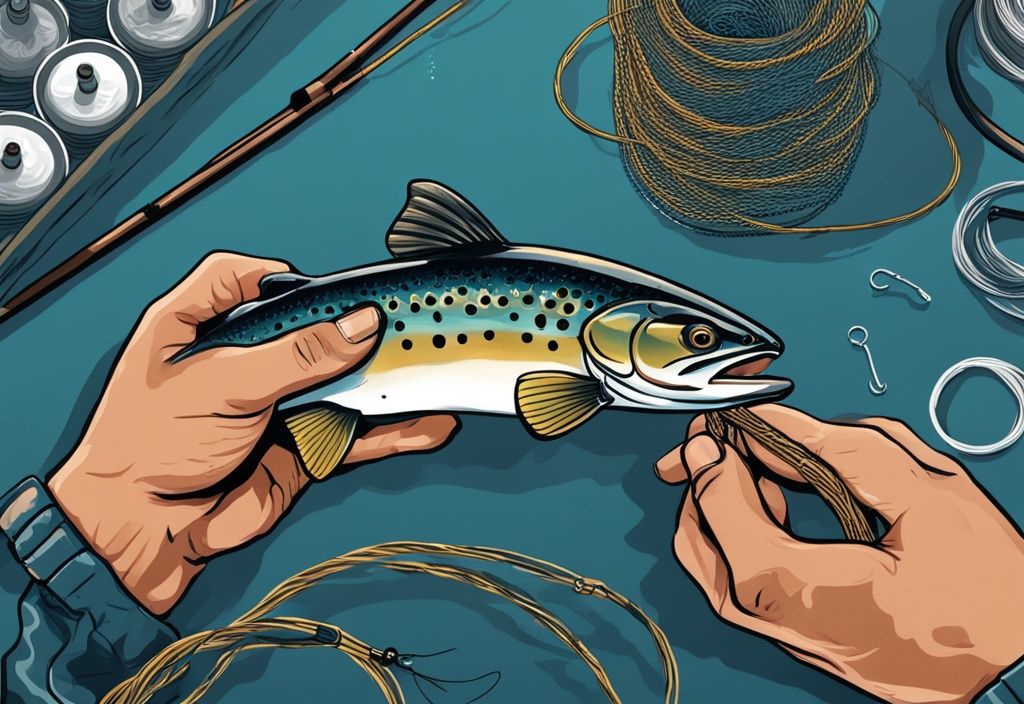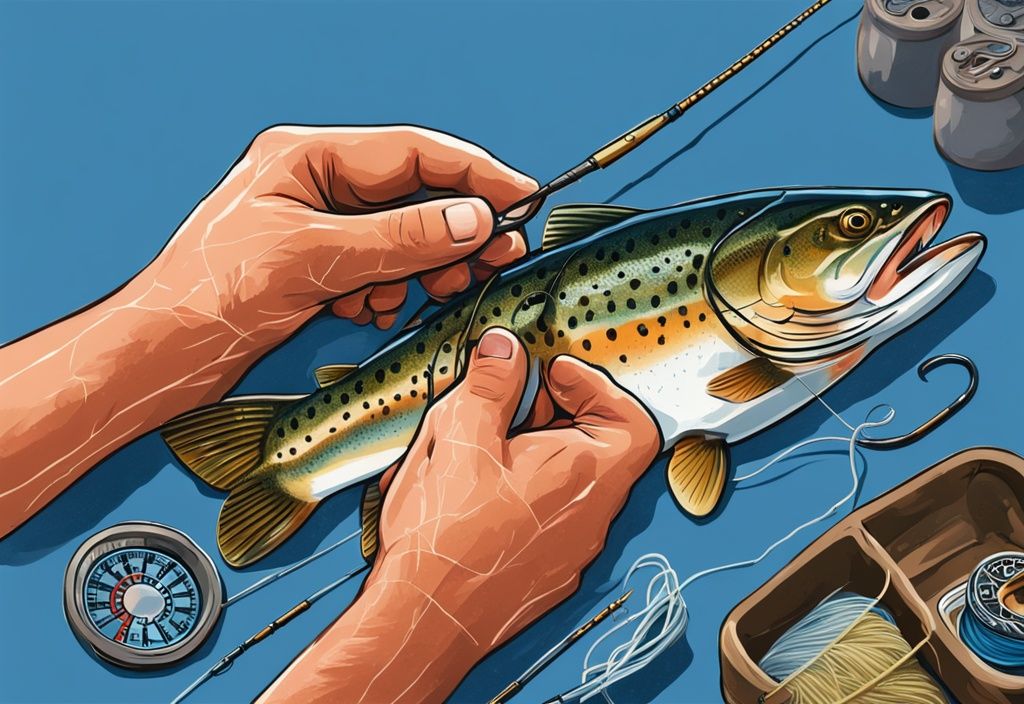Ever wondered, “what pound test for trout should I choose?” You’re not alone. In fact, selecting the right line can make or break your fishing escapade. As an angler with over two decades under my belt, I’m here to finally clear the muddy waters.
Think of it this way: your line is the link between you and the trout. Monitoring its strength, type, and condition is crucial. We’ll delve deep into the best pound tests for various trout sizes and techniques, alongside making the monofilament-braided line choice less puzzling. And trust me, there’s more to gear maintenance than meets the eye.
Stick with me to maximize your fishing success and pleasure — one catch at a time! Here’s to bringing your A-game to every fishing trip.
Introduction
Selecting the right pound test for trout is a crucial step in ensuring a successful fishing trip. Often an overlooked detail by beginners, the strength of your fishing line—measured in pounds—can make all the difference between landing your catch or losing it.
The pound test refers to the weight a line can hold before breaking. Choosing the appropriate strength is essential for both your fishing style and the conditions you’ll be facing. Imagine the excitement of feeling that first tug, only to have the line snap—it’s a crunch moment no angler wants to face.
In this article, we will delve into the nuances of line strength, the significance of choosing the right type of fishing line, and how to properly maintain it. Understanding these elements will empower you to make informed decisions that optimize your fishing experience.
Let’s explore what pound test for trout suits varying scenarios, from small streams to large lakes. We’ll cover both monofilament and braided lines, examining their benefits and drawbacks. Picture it: casting your line into a serene, mist-covered stream as you wait for that satisfying pull.
The journey to becoming a well-rounded angler involves more than just skill—it’s about making the right gear choices. Proper line maintenance ensures lasting performance, preventing those frustrating moments when your line fails at a critical juncture.
So, whether you are a novice eager to learn or an experienced angler looking to refine your technique, this comprehensive guide will equip you with the knowledge necessary for selecting the optimal fishing line to catch trout successfully. By the end, you will appreciate the balance between line strength and subtlety, crucial for increasing your catch rates and having an enjoyable fishing experience.
Understanding Pound Test: Its Relevance to Trout Fishing
What is Pound Test?
The term “pound test” refers to the tensile strength of a fishing line, essentially the maximum weight in pounds that the line can support without snapping. Picture this: You’re holding a 4-pound test line, meaning it’s designed to withstand up to 4 pounds under optimal conditions. Knowing the pound test is like having a secret weapon in your tackle box, helping anglers make smart choices about the best fishing line for their specific needs, environments, and the types of fish they aim to catch. Pretty nifty, right?
Significance of Pound Test in Trout Fishing
When it comes to trout fishing, the pound test of your line is crucial—it’s the make-or-break factor that determines your fishing success and line performance. Choosing the right pound test can skyrocket your bite rates by balancing strength and visibility. Typically, lighter lines have a lower pound test and are less visible to the trout, which can boost your chances of a bite. But here’s the kicker—you need enough strength in that line to reel in your catch successfully.
The pound test also dictates how well your line handles different water conditions. Imagine you’re fishing in crystal-clear waters; in this case, a lighter line is your best bet since it’s less noticeable. On the flip side, if you’re angling in murky waters or dealing with strong currents, you might need a stronger line to handle the extra challenges. Ultimately, picking the right pound test involves weighing several factors like line visibility, trout size, and environmental conditions to ensure a fantastic fishing experience.

Best Pound Test for Trout Fishing: A Comprehensive View
For those keen on perfecting their trout fishing game, selecting the right pound test is key. This section unwraps the intricacies of making that choice, covering essential parameters that influence an angler’s decision.
Ideal Pound Test for Trout: A Quick Look
For anglers wondering what pound test for trout would be most effective, the general recommendation falls between 2 to 6-pound test lines for small to medium trout. This range provides the right balance of subtlety and strength, essential for those delicate bites. When venturing into environments with larger trout or more challenging conditions, it’s wise to upscale to 8 to 12-pound test lines to handle the increased strain and potential for larger catches. Sport fishing enthusiasts often prefer the 2 to 4-pound range as it presents a more challenging and rewarding experience, demanding skill and finesse.
Parameters Affecting the Choice of Pound Test
Trout Size and Species
When determining what pound test for trout fishing is most suitable, it’s crucial to consider the size and species of the trout you aim to catch. For small to medium trout, a 2 to 6-pound test line typically suffices, providing enough strength without compromising on the subtlety needed for a higher bite rate. On the other hand, targeting large or trophy trout mandates stronger lines, often in the 8 to 12-pound range, to handle their size and fight. Adjust your pound test based on these expectations, ensuring that your gear can handle the demands of your fishing objectives.
Fishing Techniques in Hand
Your chosen technique significantly impacts the decision on what pound test for trout you should use. Fly fishing generally calls for lighter lines to enhance the presentation and mimic the natural movement of prey, making a 2 to 4-pound test ideal. Conventional angling techniques benefit from a balance between line strength and invisibility, often involving 4 to 6-pound test lines. Specific methods, like trolling or bottom fishing, might require stronger lines around 8 to 12 pounds due to the more aggressive nature of the fish or the need to withstand challenging underwater conditions.
Water Body and Its Conditions
The environment where you fish greatly influences the optimal pound test for trout. In clear waters, lighter lines (2 to 4-pound test) are preferred due to their reduced visibility, enhancing the chance of bites. Conversely, murky or rough waters may necessitate stronger lines (6 to 12-pound test) to endure the harsh conditions, such as debris or strong currents. When fishing in deeper or fast-moving water bodies, the additional strength of a heavier line ensures that you maintain control and increase your landing rates despite the challenging environment.
Fishing Gear and Surroundings
To determine the best pound test for trout, consider the compatibility of your line with your rod and reel. Ensure your line strength matches your gear’s specifications to avoid performance issues or potential breakages. Environmental factors also play a significant role; heavy cover or structures like rocks and vegetation might require stronger lines (6 to 12-pound test) to prevent damage while navigating these obstacles. Surveying your fishing surroundings and understanding these elements will help you select a line that not only complements your gear but also withstands the environmental challenges you face.
Choosing Between Monofilament and Braided Lines
Wondering what pound test for trout you should use? Let’s dive into the pros and cons of monofilament and braided lines for a clearer picture.
Benefits of Using Monofilament Lines for Trout
Monofilament lines have some top-notch perks when it comes to catching trout. They’re stretchy like a rubber band, providing a shock-absorbing effect perfect for those sudden thrashes of a hooked trout. This bit of give helps prevent the line from snapping, making it a lifesaver during those exhilarating fishing moments.
Another feather in monofilament’s cap is its low visibility underwater. Trout are skittish creatures, and a line they can’t see is a line they’ll bite. Higher bite rates, anyone? Because monofilament blends so well with water, you’ll find trout mistaking your lure for the real deal more often.
Ease of use is another bonus. Monofilament lines are generally easier to cast, especially those lighter weights. This is great news for beginners or anyone who loves a smooth, no-fuss casting experience. With their stealthy look and user-friendly nature, it’s no wonder why monofilament is a go-to for many trout anglers.
Why Choose Braided Lines?
Braided lines, on the other hand, bring some serious muscle to your tackle box. The main advantage? Their incredible strength. When you need higher tensile strength without a bulkier diameter, braided lines are your best bet—especially when chasing after bigger trout or navigating tough fishing environments.
These lines are also champions in tough spots. Got heavy cover or dense structures? Braided lines shine here with their low-stretch properties, letting you feel even the tiniest nibble. This sensitivity ensures quicker hook sets and better fish control.
But, of course, braided lines can be a bit finicky. They’re more visible underwater, which might spook wary trout in clear conditions. They also retain higher memory and can be trickier to handle, especially if snagged. Despite these quirks, the sheer strength and responsiveness of braided lines make them indispensable in specific scenarios, where durability and toughness are paramount.
So, when deciding what pound test for trout to use, weigh these pros and cons. Whether you opt for monofilament’s ease and stealth or braided line’s strength and sensitivity can make all the difference in your fishing adventure.

How Line Quality and Maintenance Affects Fishing Success
Regular maintenance and proper storage are key factors for ensuring your fishing line performs effectively, especially when considering what pound test for trout. Many have heard or told fish stories about ‘the one that got away,’ often due to reel or line failure that could have been prevented by some simple maintenance, as discussed in this article on line maintenance.
Routine Maintenance and Inspection for Optimum Performance
Regular maintenance and inspection of your fishing line are crucial for what pound test for trout fishing. Before embarking on any trip, anglers should inspect their lines meticulously.
Check for any frays, nicks, or signs of wear, as damaged sections significantly reduce a line’s strength and reliability. By clipping off the first few feet of the line periodically, you can ensure its integrity and performance. This regular upkeep guarantees that your line performs to its rated strength, which is vital for successfully landing trout.
How often do you really check your line? Think back to the last time you missed that big catch—could a weak spot have been the culprit?
Storing Fishing Lines: Best Practices
Proper storage of fishing lines is essential for maintaining their quality and longevity. To preserve the integrity of your lines, store them away from direct sunlight and extreme temperatures, as these elements can weaken the material.
Overloading spools can cause memory issues, leading to tangling and reduced performance. For optimal results, keep your lines in a cool, dark place. If you’re interested in exploring different techniques, you might want to learn more about what is float fishing and its benefits. Adhering to these best practices will help extend the life of your fishing lines and ensure they remain ready for what pound test for trout fishing conditions.
Ever pulled out a tangled mess of line right when the fish were biting? Horrible, isn’t it? Keeping your gear in top shape prevents those frustrating setbacks and keeps the fishing fun.
Role of Fishing Line Color in Trout Fishing
The Pros and Cons of Clear and Lightly Tinted Lines
Clear and lightly tinted lines are a favorite among trout anglers, offering a stealthy presence in the water. These lines are perfect when fishing in crystal-clear conditions because they don’t spook the fish. Imagine the thrill when a cautious trout bites because your line seamlessly blends into the watery backdrop. That’s the magic of clear and lightly tinted lines.
But there’s a catch. These lines can be tricky to see above the water. Picture yourself squinting against the sun, trying to track your line. You might miss those subtle movements or struggle to position the line just right, which can impact your fishing experience.
Ultimately, clear and lightly tinted lines strike a balance between being nearly invisible and enhancing your bite chances, making them ideal for stealthy fishing adventures in clear waters.
When to Opt for Colored Lines
Colored lines are your best friend in murky or stained waters. Their visibility makes it much easier to monitor and control your line. Think of those times when the water’s as clear as mud; colored lines will help you track every twitch and movement.
However, these lines aren’t always a free pass. Their high visibility can sometimes reduce bite rates because the fish might be spooked. Picture a trout eyeing your neon line warily and swimming away.
Still, colored lines shine in conditions where keeping an eye on your line is more critical than staying hidden. They offer a great way to maintain control and precision, especially with fast-moving or deeply submerged fish. Choose your line wisely based on the water clarity and your target species.
Frequently Asked Questions
What Pound Test for Trout: Common Queries Answered
What is the best pound test line for trout fishing?
Best practice: For most trout fishing scenarios, a 2 to 6-pound test line does the trick nicely. It’s flexible enough for different conditions and gives you a good balance of strength and finesse. Adapt based on fish size, water clarity, and technique.

Is a 6-pound test line adequate for trout fishing?
Adequacy: Absolutely, a 6-pound test line is quite a reliable choice, especially if you’re targeting medium-sized trout. It strikes a good balance in environments with additional challenges.
Trade-offs: While you might notice reduced castability, the extra strength and control it offers often makes up for it.
Why is monofilament line commonly preferred for trout fishing?
Advantages: Monofilament lines are a favorite among anglers because they’re less visible underwater, stretchable, and offer better castability. Plus, they’re quite user-friendly—especially if you’re just starting out.
Performance: Monofilament is ideal for beginners and works well in general trout fishing conditions.
How does water clarity influence the choice of fishing line?
Clear water: In crystal-clear streams, lighter and less visible lines are key to avoid spooking the fish.
Murky water: When dealing with murky water, stronger lines that are slightly tinted can be more visible to you without alerting the trout.
Conclusion
When considering what pound test for trout to use, selecting the right line strength is key to a successful fishing experience. The pound test significantly influences your fishing success, determining both the durability of the line and its visibility underwater. Anglers need to strike a delicate balance between using a line robust enough to handle the trout’s weight while being subtle enough to avoid startling these often cautious fish.
For most trout fishing scenarios, a 2 to 6-pound test line is generally recommended. It provides a satisfying blend of strength and finesse. However, when targeting larger trout or fishing in more challenging conditions, an 8 to 12-pound test line might be necessary. This choice can offer higher assurance against line breaks while contending with more aggressive fish or rougher environments.
It’s essential to adjust the pound test based on specific factors like trout size, species, water clarity, and fishing techniques. Tailoring your line choice to these variables ensures you’re adequately equipped for a productive fishing day. For instance, using lighter lines in clear waters increases your chances of catching trout, as they are less likely to see and evade your bait. Conversely, murky or rough waters might demand a stronger line to handle the environmental stressors.
Understanding what pound test for trout to use and tailoring your choice based on your fishing conditions, gear, and targeted trout size will enhance your chances of enjoying a successful and rewarding fishing experience. Balancing line strength and subtlety is the key to optimizing your catch rates.
Incorporate these recommendations to ensure your time on the water is both productive and enjoyable. Adapt your gear to meet the demands of each unique fishing adventure. Every trout fishing trip comes with its own set of challenges and joys, making the right line choice as crucial as your skill and patience.


